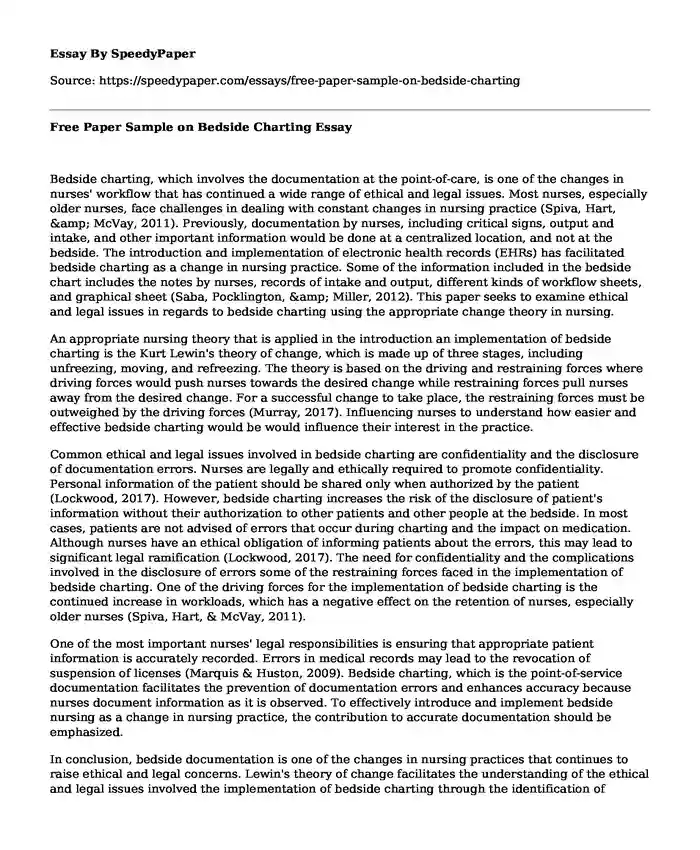
| Type of paper: | Research paper |
| Categories: | Nursing care |
| Pages: | 3 |
| Wordcount: | 659 words |
Bedside charting, which involves the documentation at the point-of-care, is one of the changes in nurses' workflow that has continued a wide range of ethical and legal issues. Most nurses, especially older nurses, face challenges in dealing with constant changes in nursing practice (Spiva, Hart, & McVay, 2011). Previously, documentation by nurses, including critical signs, output and intake, and other important information would be done at a centralized location, and not at the bedside. The introduction and implementation of electronic health records (EHRs) has facilitated bedside charting as a change in nursing practice. Some of the information included in the bedside chart includes the notes by nurses, records of intake and output, different kinds of workflow sheets, and graphical sheet (Saba, Pocklington, & Miller, 2012). This paper seeks to examine ethical and legal issues in regards to bedside charting using the appropriate change theory in nursing.
An appropriate nursing theory that is applied in the introduction an implementation of bedside charting is the Kurt Lewin's theory of change, which is made up of three stages, including unfreezing, moving, and refreezing. The theory is based on the driving and restraining forces where driving forces would push nurses towards the desired change while restraining forces pull nurses away from the desired change. For a successful change to take place, the restraining forces must be outweighed by the driving forces (Murray, 2017). Influencing nurses to understand how easier and effective bedside charting would be would influence their interest in the practice.
Common ethical and legal issues involved in bedside charting are confidentiality and the disclosure of documentation errors. Nurses are legally and ethically required to promote confidentiality. Personal information of the patient should be shared only when authorized by the patient (Lockwood, 2017). However, bedside charting increases the risk of the disclosure of patient's information without their authorization to other patients and other people at the bedside. In most cases, patients are not advised of errors that occur during charting and the impact on medication. Although nurses have an ethical obligation of informing patients about the errors, this may lead to significant legal ramification (Lockwood, 2017). The need for confidentiality and the complications involved in the disclosure of errors some of the restraining forces faced in the implementation of bedside charting. One of the driving forces for the implementation of bedside charting is the continued increase in workloads, which has a negative effect on the retention of nurses, especially older nurses (Spiva, Hart, & McVay, 2011).
One of the most important nurses' legal responsibilities is ensuring that appropriate patient information is accurately recorded. Errors in medical records may lead to the revocation of suspension of licenses (Marquis & Huston, 2009). Bedside charting, which is the point-of-service documentation facilitates the prevention of documentation errors and enhances accuracy because nurses document information as it is observed. To effectively introduce and implement bedside nursing as a change in nursing practice, the contribution to accurate documentation should be emphasized.
In conclusion, bedside documentation is one of the changes in nursing practices that continues to raise ethical and legal concerns. Lewin's theory of change facilitates the understanding of the ethical and legal issues involved the implementation of bedside charting through the identification of restraining and driving forces. Ethical and legal issues involved include confidentiality, the disclosure of documentation errors, and the need for accuracy in documentation.
References
Lockwood, W. (2017). Medical Record Documentation and Legal Aspects. Retrieved June 27, 2018, from http://www.rn.org/courses/coursematerial-215.pdf
Marquis, B. L., & Huston, C. J. (2009). Leadership Roles and Management Functions in Nursing: Theory and Application. Alphen aan den Rijn, Netherlands: Wolters Kluwer Health.
Murray, E. (2017). Nursing Leadership and Management: For Patient Safety and Quality Care. Philadelphia, USA: E.A Davis Company.
Saba, V. K., Pocklington, D. B., & Miller, K. P. (2012). Nursing and Computers: An Anthology, 1987-1996. New York, USA: Springer.
Spiva, L., Hart, P., & McVay, F. (2011). Discovering Ways that Influence the Older Nurse to Continue Bedside Practice. Nursing Research and Practice, 1-8.
Cite this page
Free Paper Sample on Bedside Charting. (2022, Jun 24). Retrieved from https://speedypaper.net/essays/free-paper-sample-on-bedside-charting
Request Removal
If you are the original author of this essay and no longer wish to have it published on the SpeedyPaper website, please click below to request its removal:
- Essay Example: Travel and Tourism Industry Analysis
- Thematic Synthesis Essay Example
- Leadership of Richard Branson - Essay Sample
- Paper Example: Reading Assignment and Answering Questions
- Essay Example with the Article Review: Disability in Sport
- Paper Example on Change Resistance Management Approach
- Free Essay: An Analysis of Foer's World without a Mind and Coates' The First White President
Popular categories




